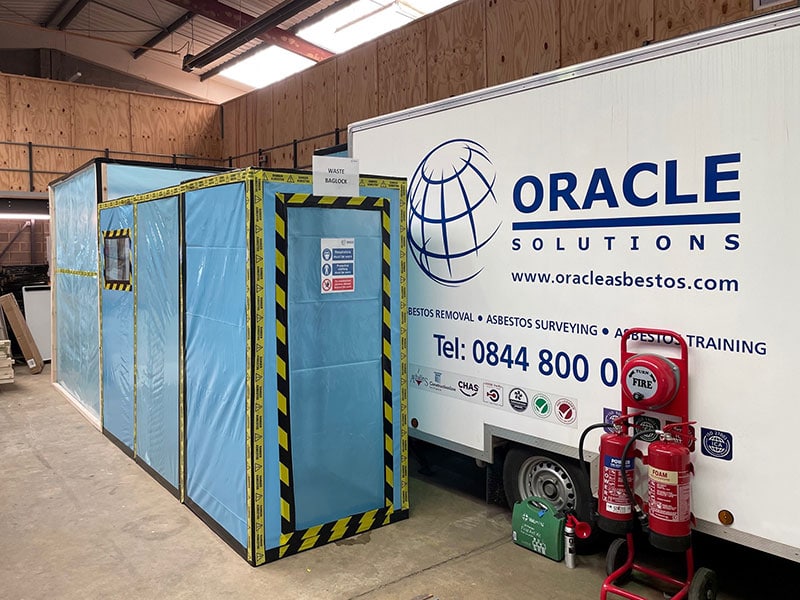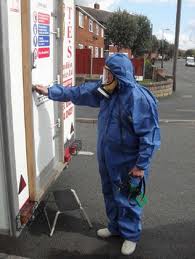What is the role of asbestos decontamination units in licensed removal work?
When licensed asbestos removal is being carried out – an operation that, as the term “licensed” indicates, must only be done by a contractor holding a licence from the Health and Safety Executive (HSE) – it is also of the utmost importance to make sure all the appropriate and necessary decontamination procedures are followed.
Decontamination is a critical component of licensed asbestos removal work. It is a process that greatly helps to prevent any spread of the carcinogenic substance from the site where the asbestos removal work is being carried out. This, in turn, contributes to legal compliance, as well as to keeping workers and other potentially at-risk individuals safe.

What is a decontamination unit in asbestos removal?
The term “decontamination unit” refers to the main facility that is used for decontamination after licensed asbestos work has been carried out. It is also sometimes called a “hygiene unit” or “DCU”.
It is extremely important to make sure the design and specifications of a decontamination unit comply with certain minimum criteria. The typical hygiene unit has a “dirty end” at one end, and a “clean end” at the other, with showers separating the two. The “dirty end” incorporates an extraction ventilation unit, while the “clean end” has a well-sealed self-closing door, and between the showers and the “clean end” can be found a grill with self-closing flap.
A DCU can take a mobile (temporary), fixed, or modular form. “Mobile” and “modular” facilities are the most common types, while converted welfare facilities would be an example of a “fixed” type of hygiene unit to have been historically used.
A “mobile” decontamination unit can be defined as a caravan-style or relocatable self-contained unit that can be towed to the site. As this type of unit is generally larger than a modular one – which allows for greater comfort and space for thorough decontamination – a mobile unit should be used in preference to a modular one.
If a DCU is referred to as “modular”, on the other hand, this describes a panel-based system that makes possible the swift construction of facilities on-site. However, this type of unit should only be used where space does not permit a mobile unit to be used, and where its use removes the need for transit procedures.
Why are decontamination units necessary in asbestos removal?
Although all types of asbestos were banned for importation and use way back in 1999, the dangers that the fibrous silicate mineral poses to human health are sadly still an acutely important issue in the 2020s.
When someone breathes in or ingests asbestos fibres, they can be at heightened risk of developing a potentially fatal asbestos-related disease, such as mesothelioma or asbestos-related lung cancer. The latency period for such conditions can be up to 50 years after the incident of asbestos exposure, which helps to explain why approximately 5,000 people a year in the UK still die from asbestos-related disease every year.
Such risks can be mitigated, however, if suitably stringent procedures are followed for asbestos removal jobs today. Decontamination certainly plays an imperative role here, by minimising the scope for asbestos to be spread away from the work site to the broader environment.
The UK’s present legal and regulatory framework around asbestos management further underscores the importance of effective decontamination after licensed asbestos removal work.
Regulation 16 of the Control of Asbestos Regulations 2012 (CAR 2012) – on “the duty to prevent or reduce the spread of asbestos” – sets out that “every employer must prevent or, where this is not reasonably practicable, reduce to the lowest level reasonably practicable the spread of asbestos from any place where work under the employer’s control is carried out.”
How do decontamination units work?
Any given personnel – including workers and others – who enter a designated work area or enclosure are likely to become contaminated with asbestos. This means it is critically important for them to decontaminate themselves whenever they leave such an area where licensed asbestos removal is taking place.
We have set out the three-stage process below. It is designed in such a way as to ensure workers clean themselves and their personal protective equipment (PPE) and respiratory protective equipment (RPE), thereby preventing asbestos from being spread beyond the enclosure.
- Prevent or minimise contamination inside the enclosure or designated work area. The aim of this step is to avoid becoming contaminated in the first place. Licensed asbestos removal work should always be undertaken in a way that minimises the amount of dust and debris produced.
- Preliminary decontamination within the enclosure and airlocks. This is the stage at which the bulk of contamination should be removed from the PPE and RPE.
- Final decontamination within the hygiene unit. At this stage, any remaining residual contamination is removed, and workers change back into domestic clothing.
To help ensure the decontamination process is effective, it is also crucial that the DCU is well-ventilated. This should entail air being drawn in at the “clean end”, passing through the shower, and being discharged at the “dirty end”. Discharge of the air should occur via a HEPA filter or absolute filter, or via a pre-filter.
How are decontamination units used in asbestos removal projects?

The exact procedures for entry and decontamination will depend on the site’s layout and whether the decontamination unit is directly attached to the enclosure – a situation known as “non-transiting” – or is remote from the enclosure (“transiting”).
It is preferrable, if possible, for the DCU to be attached to the enclosure (“non-transiting”), as this allows for a simpler and shorter decontamination process, while reducing the potential for asbestos spread beyond the enclosure. However, this arrangement might not be reasonably practicable in all circumstances.
At the point of the individual leaving the enclosure, it is essential for all contaminated items – encompassing coveralls, footwear, and RPE – to be cleaned, with all footwear and RPE being replaced or covered. Transit coveralls – which are usually a different colour to work coveralls – and footwear should be worn by an individual who is travelling to and returning from the enclosure.
It is in the middle stage of the airlock where used work coveralls should be removed; these will need to be disposed of as hazardous waste or stored for reuse, such as after meal breaks.
With regard to used work footwear, this can be stored in the middle stage of the airlock after use, or covered with “overshoes” during transiting. New work coveralls – in other words, coveralls that are clean and unused – should be worn under transiting coveralls on the journey to the enclosure.
What training is required for using decontamination units?
The decontamination process will need to be covered in the broader training provided to licensed asbestos removal operatives. This aspect of the contractor’s training must give them the knowledge and skills that they require in order to ensure proper and effective decontamination.
The training in decontamination procedures that is provided to workers should involve practising how to decontaminate in a simulated environment. It is especially important for asbestos removal contractors to acknowledge the need for primary decontamination during the transit process.
Licensed asbestos removal workers should also be well-trained in the relevant maintenance and emergency procedures for the use of DCUs. In the event, for example, of loss of services to a given hygiene unit, there should be contingency plans already in place for alternative basic decontamination procedures. These plans should be well-communicated to workers and supervisors, so that they will know how to act.
Our comprehensive guide to asbestos training covers the general training requirements for licensed asbestos work. Ensuring any worker in your employment is suitably trained will greatly help ensure their competency in the tasks they carry out, including in relation to decontamination.
How are decontamination units maintained and inspected?
Best practices for the maintenance, cleaning, and inspection of decontamination units must be followed, to ensure they continue to be effective and safe for use.
Various daily and weekly checks of the DCU will need to be carried out by a supervisor. These should encompass daily checks of such aspects as the water, gas and electricity supplies, the operation of the heating system, and the operation of the negative pressure unit (NPU). The latter should include scrutinising the pressure gauge/warning device, to guard against the risk of the HEPA filter becoming saturated.
Alongside the above checks, weekly visual checks of the electrical equipment should be undertaken, watching for signs of anything adverse such as damage, wear, or overheating.
Checks, examination, and testing will need to be carried out by suitably competent individuals. For more detailed information on what these maintenance and inspection processes for a DCU should entail, as well as about other aspects of asbestos decontamination, please consult the HSE’s free-to-download Asbestos: The licensed contractors’ guide document, under the series code HSG247.
Conclusion: the critical role of decontamination units in ensuring safe asbestos removal
When it comes to ensuring not only the workers themselves, but also other personnel and the wider environment are protected during and after licensed asbestos removal projects, decontamination units play a critical role. They also help employers fulfil their legal duty to take every reasonable step to prevent asbestos from spreading beyond the enclosure or designated work area.
So, if you are looking to have licensed asbestos removal work carried out at a given site, you must ensure compliance with the regulations and best practices. This will be key to maximising the safety and effectiveness of your decontamination processes.
Are you seeking out accredited and licensed asbestos services – including asbestos removal – to help put your mind at rest? If so, please feel free to call the Oracle Solutions team today.

Written by Callum McDonald
Callum McDonald is an expert in asbestos quality management, ensuring rigorous adherence to regulations and high-quality standards in removal projects. His focus on enhancing quality and client satisfaction makes him a crucial asset in safety and compliance within the field. Callum's expertise in technical support and oversight of licensed works underscores his commitment to excellence in asbestos management, providing invaluable guidance to clients in this specialised area.
